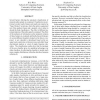Free Online Productivity Tools
i2Speak
i2Symbol
i2OCR
iTex2Img
iWeb2Print
iWeb2Shot
i2Type
iPdf2Split
iPdf2Merge
i2Bopomofo
i2Arabic
i2Style
i2Image
i2PDF
iLatex2Rtf
Sci2ools
ISMIR
2004
Springer
2004
Springer
Features and classifiers for the automatic classification of musical audio signals
Several factors affecting the automatic classification of musical audio signals are examined. Classification is performed on short audio frames and results are reported as “bag of frames” accuracies, where the audio is segmented into 23ms analysis frames and a majority vote is taken to decide the final classification. The effect of different parameterisations of the audio signal is examined. The effect of the inclusion of information on the temporal variation of these features is examined and finally, the performance of several different classifiers trained on the data is compared. A new classifier is introduced, based on the unsupervised construction of decision trees and either linear discriminant analysis or a pair of single Gaussian classifiers. The classification results show that the topology of the new classifier gives it a significant advantage over other classifiers, by allowing the classifier to model much more complex distributions within the data than Gaus...
| Added | 02 Jul 2010 |
| Updated | 02 Jul 2010 |
| Type | Conference |
| Year | 2004 |
| Where | ISMIR |
| Authors | Kristopher West, Stephen Cox |
Comments (0)

